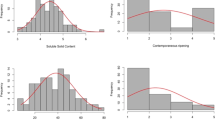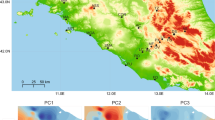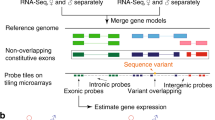Summary
The determination of rate of growth in a genetically replicated diallel set of crosses between six dikaryotic selection lines of Schizophyllum commune has been examined at 15°, 20°, 25° and 30°C. Three of the lines had been selected for low growth rate on the basis of their performance at 20°C, 30°C or at both temperatures and three for high growth rate on the basis of their performance in one or other of these three environments.
The genetical control of rate of growth itself has been analysed in each of the four environments and in addition the rate of growth of each mating in the four environments has been converted into two components each of which measures a different aspect of sensitivity to temperature; general sensitivity which is a linear function of mean rate of growth and specific sensitivity which is independent of it. From genetical analysis of these two components we have drawn conclusions about the genetical architecture of rate of growth and of its interaction with temperature and about the genetical basis of the differences among the six selection lines.
All are largely explicable in terms of additive and dominance gene action with dominance mainly in the direction of faster growth and greater temperature sensitivity. The interactions between rate of growth and temperature that are independent of rate of growth itself involve epistatic gene interactions that can be traced to changes in the dominance relationships of fast and slow growth rate alleles with temperature. The differences among the three low selections and among the three high selections which can be related to the temperature in which they were selected are due to recessive alleles which are fully expressed only in the temperature of selection.
Similar content being viewed by others
Article PDF
References
Connolly, V, and Simchen, G. 1973. Two-environment selection with inbreeding in Schizophyllum commune. Genet Res, Camb, 22, 25–36.
Coughtrey, A, and Mather, K. 1970. Interaction and gene association and dispersion in diallel crosses where gene frequencies are unequal. Heredity, 25, 79–88.
Hayman, B I. 1954. The analysis of variance of diallel tables. Biometrics, 10, 233–244.
Hill, J. 1964. Effects of correlated gene distributions in the analysis of diallel crosses. Heredity, 19, 27–46.
Jinks, J L. 1954. The analysis of continuous variation in a diallel cross of Nicotiana rustica varieties. Genetics, 39, 767–788.
Jinks, J L. 1955. A survey of the genetical basis of heterosis in a variety of diallel crosses. Heredity, 9, 223–238.
Jinks, J L. 1956. The F2 and backcross generations from a set of diallel crosses. Heredity, 10, 1–30.
Jinks, J L, and Connolly, V. 1973. Selection for specific and general response to environmental differences. Heredity, 30, 33–40.
Jinks, J L, and Connolly, V. 1975. Determination of the environmental sensitivity of selection lines by the selection environment. Heredity, 34, 401–406.
Mather, K. 1967. Complementary and duplicate gene interaction in biometrical genetics. Heredity, 22, 97–103.
Mather, K, and Jinks, J L. 1971. Biometrical Genetics. Chapman Hall, London.
Simchen, G, and Jinks, J L. 1964. The determination of dikaryotic growth rate in the basidiomycete, Schizophyllum commune: a biometrical analysis. Heredity, 19, 629–649.
Author information
Authors and Affiliations
Rights and permissions
About this article
Cite this article
Connolly, V., Jinks, J. The genetical architecture of general and specific environmental sensitivity. Heredity 35, 249–259 (1975). https://doi.org/10.1038/hdy.1975.89
Received:
Issue date:
DOI: https://doi.org/10.1038/hdy.1975.89
This article is cited by
-
Environmental sensitivity and heterosis for egg laying in Drosophila melanogaster
Theoretical and Applied Genetics (1989)
-
Allozyme heterozygosity and homeostasis in germinating seeds of jack pine
Heredity (1987)
-
Determination of the environmental sensitivity of selection lines of Nicotiana rustica by the selection environment
Heredity (1982)
-
The possible polyphyletic origin of copper tolerance inAgrostis tenuis (Gramineae)
Plant Systematics and Evolution (1982)
-
The analysis of genotype × environment interactions: What does it mean if varietal stability is linearly related to varietal performance?
Euphytica (1981)



